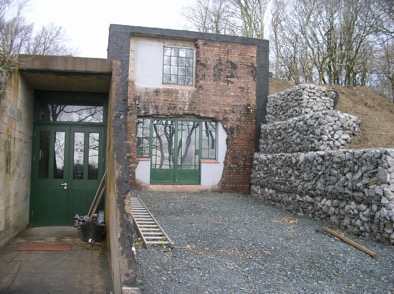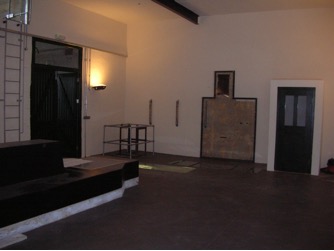 There are still many World War and Cold War structures scattered across The Lizard landscape. They range from a WW1 Airship Station all the way through to secret WW2 radar and later Cold war installations, all of which required an elaborate network of buildings, roads and communications systems and barracks for the many personnel who came made their war time homes here.
There are still many World War and Cold War structures scattered across The Lizard landscape. They range from a WW1 Airship Station all the way through to secret WW2 radar and later Cold war installations, all of which required an elaborate network of buildings, roads and communications systems and barracks for the many personnel who came made their war time homes here.
Now, as part of their Environmental Stewardship agreement with Natural England, The Tylor family invite local school groups out onto their land at Lanarth to discover at first-hand how they manage the countryside for both food production and its rich wildlife and historic interests. As part of their educational access work there soon became a need for Micky Tylor to find a suitable building that could be used as an on-farm classroom so that wet weather and washing facilities could be provided for the children’s visits.
One such building, the old generator block for RAF Trelanvean had, like many of the other military structures in the area, spent the last half century quietly mouldering away amongst a dense tangle of Rhododendron and Laurel at Twenty Acre Plantation on Lanarth and it soon became obvious that this could provide both a good sized and exciting venue for school children at the same time as giving the building a new lease of life for the wider community to also use and appreciate in the longer term.
As part of the first phase of the restoration, an archaeological audit and assessment was commissioned to ensure the full historic interest could be taken into account during the restoration works and thereby ensure that key features that still survived the decades of natural deterioration and human interference would be preserved. The report also captured some great stories and reflections from people who lived and worked in the area during the wartime years, some of whom still live locally.
 The study revealed that the bunker had housed a very large generator that provided the power to RAF Trelanvean, one of the country’s network of secret Chain Home Early Warning radar stations. This network was built around the British coast before and during WW2 and was the first radar to be organised into a complete air defence system for wartime operations. Located nearby are several ancillary buildings including transmitter blocks, a guardhouse and toilets and an elaborate complex of underground ducts for cables and water.
The study revealed that the bunker had housed a very large generator that provided the power to RAF Trelanvean, one of the country’s network of secret Chain Home Early Warning radar stations. This network was built around the British coast before and during WW2 and was the first radar to be organised into a complete air defence system for wartime operations. Located nearby are several ancillary buildings including transmitter blocks, a guardhouse and toilets and an elaborate complex of underground ducts for cables and water.
During the restoration phase a balance was struck between needing to reveal the bunker and other buildings in the Plantation. By carefully clearing the dense growth of evergreen scrub, the structures and trees were left in a safe and sound condition whilst not inadvertently altering the historic story of the site. As the clearance work progressed during 2013 and 14 many local people would comment on how amazing the site looked as it was gradually opened up and, although they knew some buildings were in there, has not really appreciated their size and number. Finishing touches will include providing a suitable car park and the Plantation will be managed for its wildlife and landscape value.
Micky Tylor of Lanarth says: ‘This project with Natural England and Cornwall Council has provided us with a great opportunity to re-use an old building that was on the verge of being lost forever. Although it is largely made of thick concrete and covered with earth, nature was doing very well at reclaiming it, with tree roots starting to penetrate the roof and water seeping in, so it was only a matter of time before it became completely derelict. What we now have is a superb asset that we can use for visiting schools and other local groups as an educational and community facility. It provides not only an essential farm classroom and meeting space but also one that offers a unique insight into what it must have been like for RAF Trelanvean operators during World War 2.’
Ann Reynolds, Senior Archaeologist for Cornwall Council and who has worked closely on the project says: ‘It is fantastic that Mr Tylor saw the opportunity these features presented to the farm and that Natural England were willing to support their rescue. The attention to detail shown by Tim Pickett and Greystone Moore in staying true to 1940’s colours and designs, and preserving original features as far as possible is a testament to the skill and care that has been carried out on this project. This is such an important site, both locally and nationally, and demonstrates the important role the Lizard played during the war’.
Charlie Johns, Project Manager, Historic Environment Projects for Cornwall Council, says: ‘This was a fascinating project to work on. The archaeological survey of the radar station was like rediscovering a forgotten world. WW2 radar stations such as RAF Trelanvean and RAF Dry Tree (on Goonhilly Downs) have left a unique imprint on the landscape of the Cornish peninsula and serve as reminder of the global conflicts and fast changing technology of the 20th century. As well as their national and international resonance they have local significance through the links that developed between the military sites and local communities as well as the strong associations with the individual service personnel who manned them during the wars.
 Eva Capon’s story was written onto the BBC People’s War website story. Eva trained as a radar technician at RAF Yatesbury and after a four week training was sent to RAF Great Bromley, a Radar Station in Essex. She stayed at that station for a year and in the spring of 1942 she came down to Cornwall, to RAF Trelanvean. She was promoted to Corporal and had a lovely summer, they spent many of their off-duty hours on the beach, especially Coverack, and she organised a cricket team. One weekend, three of the WAAFs had passes and hitchhiked to Falmouth were they stayed the night at the Greenbank Hotel and went dancing in the Princess Pavilion. The trouble was that on Sunday they could not get lifts easily and were late back for their shift. Their punishment was ‘jankers’ (being confined to camp), which was spent sunbathing outside the huts!
Eva Capon’s story was written onto the BBC People’s War website story. Eva trained as a radar technician at RAF Yatesbury and after a four week training was sent to RAF Great Bromley, a Radar Station in Essex. She stayed at that station for a year and in the spring of 1942 she came down to Cornwall, to RAF Trelanvean. She was promoted to Corporal and had a lovely summer, they spent many of their off-duty hours on the beach, especially Coverack, and she organised a cricket team. One weekend, three of the WAAFs had passes and hitchhiked to Falmouth were they stayed the night at the Greenbank Hotel and went dancing in the Princess Pavilion. The trouble was that on Sunday they could not get lifts easily and were late back for their shift. Their punishment was ‘jankers’ (being confined to camp), which was spent sunbathing outside the huts!
http://www.bbc.co.uk/history/ww2peopleswar/
Mrs Kathleen McLeod was also radar operator here for two years from 1942 she remembered Moore’s Garage (now Zoar garage) down the road and that St Keverne was their drinking haunt! She also sent some photos, scanned from her photo album.’
Jeremy Clitherow, Lead Adviser for Natural England, says: ‘This project has been very exciting as it has not only helped to restore a ‘lost’ WW2 building but provides a fantastic teaching resource for local schools and, when you visit it, conjures up a strong feeling of what it must have been like for people working there during the difficult years of WW2.’
Published: Dec 2015
Author: Jeremy Clitherow, Lead Adviser for Natural England
